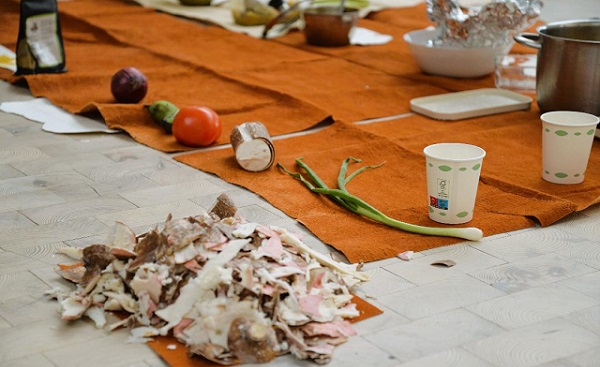
An installation of Ugandan food stuffs traverse themes of culinary traditions and communal dinning at a cultural exhibition by Ugandan post graduate Student in Norway
ART | DOMINIC MUWANGUZI There is no limit to what art can be, made out of or represent within the scope of contemporary art. A recent Food installation, “Olugulilo” dining experience, by Ugandan post graduate student Kajebe Jacob Joshua from Makerere University School of Industrial and Fine art who is on an exchange program at Bergen, University Norway, reverberate the latter statement. The young artist creates an ephemeral installation made out of popular Ugandan foods including Cassava, beans and cowpeas that evoke Ugandan cuisines while navigating the concept of culinary traditions and communal dining. As such the artwork is a platform for cultural exchanges in a foreign land and artistic experimentation under the theme of ‘Community Centric Approaches to Mental Health through mixed media printing’.
The artist’s specialty is printmaking and is a strong advocate for mental health and community engagement. These two characteristics of his artistic practice inform his experimental processes in this particular installation. For example, as a printmaker he uses one of the oldest techniques in artmaking to document the installation therefore creating posterity for this temporary artwork. Similarly, working with barkcloth in the installation incites conversations about his cultural heritage among a new audience. It is also symbolic to his cultural consciousness that elevates the artwork to a status of an authentic and original piece of art. Nonetheless, the artist argues while he prepared the cassava; cutting it into small pieces like dices; the process felt like a delicate engraving of wood. “Each slice of cassava felt akin to engraving wood; a therapeutic endeavour of extracting the essence while discarding the superfluous,” he writes in the concept note to the project.

Aside from the technique and medium deployed to produce this one-of-a-kind installation, the eventual outcome of such exploratory work was exciting. The artist observes, “the culmination of this event was not merely a gastronomic indulgence but a catalyst for meaningful dialogue and cultural exchange.” In this, the artist achieved two objectives: Firstly, as a contemporary artist he created a space where diverse voices could converge and narratives could intersect and secondly, as a strong advocate for mental health and community engagement, he promoted the inherent therapeutic value of shared experiences. In both scenarios, the audience played a pivotal role therefore underscoring the importance of varied audiences in the visual arts.
Such a creative undertaking, suggest the benefits of breaking the norms of traditional artmaking and not only in terms of technique or material used, but the type of audience who are consuming the art on showcase. For this particular installation, its success- observed through the chorus of remarkable responses from the guests who had a taste of the food- was inevitable because it was an authentic representation of Ugandan culture in a foreign land. Conversely, the same installation would have struggled to receive a similar reception back home because of the generally held perception among the local audience that it is not or does not fall under the definition of art. With such a limitation to what art is, the artist’s creative faculty is unfortunately silently undercut propagating the production of art that does not challenge the status quo.

But this ephemeral installation that also doubles as performance art is a testimony to the artist’s creative prowess and boldness. Though the work is an inspiration from Judy Chicago’s iconic installation “The Dinner Party,” the artist’s ability to contextualize the concept of food installation into his indigenous culture and export it to a new audience is impressive. The idea of working with everyday themes, for example food, suggest an artist who is deeply knowledgeable of his social- cultural heritage and is committed to preserve it through art. In many traditional societies across the continent, food is interpreted as a communal object which brings people together. During meal times, the family- usually extended- sit together to eat and share their joys and sorrows. It is a medium through which different conversations can be triggered and solutions to problems can be found.
Through the blend of art, culinary traditions and communal dining the artist constructs an installation that breaks the norms of everyday artmaking. This approach is a potent way of triggering conversations around the art because it immediately arouses curiosity and mystery. While the audience at Bergen University may have easily appreciated the artistry that runs through the work of art, back home, the installation will generally be interpreted as a novel experience with little excitement and acknowledgement. But it is probably such reception that will prompt more artists like Kajebe to be bold in their artistic practice and transcend the usual thereby reaching new territories with their art.
 The Independent Uganda: You get the Truth we Pay the Price
The Independent Uganda: You get the Truth we Pay the Price



good work